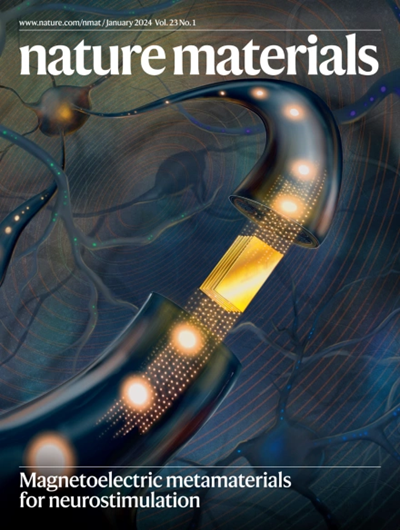Near-100% spontaneous rolling up of polar van der Waals materials.
IF 38.5
1区 材料科学
Q1 CHEMISTRY, PHYSICAL
引用次数: 0
Abstract
Rolling two-dimensional materials into one-dimensional nanoscrolls introduces curvature, chirality and symmetry breaking, enabling emergent properties. Conventional methods relying on external driving forces, however, exhibit poor control, low yield and limited reproducibility. Here we report spontaneous scrolling in polar van der Waals materials via an electrochemical intercalation/exfoliation process, enabling scalable nanoscroll production. This self-rolling is driven intrinsically by out-of-plane electric polarization (P⊥), where the magnitude of P⊥ is modulated by the intercalant size. Validated across eight polar materials, this approach achieves virtually 100% yield and reproducibility with defined scrolling direction, surpassing external driving force limitations. The nanoscrolls exhibit layer-independent inversion symmetry breaking and coherently enhanced second-harmonic generation, exceeding two-dimensional flakes by ~100-fold and rivalling leading two-dimensional nonlinear materials. Electrochemical initiation further facilitates metal-ion co-intercalation, yielding ten hybrid nanoscroll architectures. These findings establish a scalable route to create one-dimensional nanostructures and hybrid heterostructures, paving the way for designer quantum solids and van der Waals superlattices in quantum nanodevices.几乎100%的极性范德华物质自发卷起。
将二维材料轧制成一维纳米卷会引入曲率、手性和对称性破缺,从而实现涌现特性。然而,传统的方法依赖于外部驱动力,表现出控制差、产量低和重复性有限的特点。在这里,我们报道了极性范德华材料通过电化学插层/剥离过程的自发滚动,实现了可扩展的纳米滚动生产。这种自滚动本质上是由面外电极化(P⊥)驱动的,其中P⊥的大小是由插层尺寸调制的。在八种极性材料中进行了验证,该方法在确定滚动方向的情况下实现了几乎100%的成品率和再现性,超越了外部驱动力的限制。纳米卷轴表现出与层无关的反转对称破缺和相干增强的二次谐波产生,超过二维薄片约100倍,与领先的二维非线性材料相媲美。电化学引发进一步促进了金属离子共插层,产生了十种杂化纳米卷结构。这些发现为创建一维纳米结构和混合异质结构建立了一条可扩展的途径,为量子纳米器件中的量子固体和范德华斯超晶格的设计铺平了道路。
本文章由计算机程序翻译,如有差异,请以英文原文为准。
求助全文
约1分钟内获得全文
求助全文
来源期刊

Nature Materials
工程技术-材料科学:综合
CiteScore
62.20
自引率
0.70%
发文量
221
审稿时长
3.2 months
期刊介绍:
Nature Materials is a monthly multi-disciplinary journal aimed at bringing together cutting-edge research across the entire spectrum of materials science and engineering. It covers all applied and fundamental aspects of the synthesis/processing, structure/composition, properties, and performance of materials. The journal recognizes that materials research has an increasing impact on classical disciplines such as physics, chemistry, and biology.
Additionally, Nature Materials provides a forum for the development of a common identity among materials scientists and encourages interdisciplinary collaboration. It takes an integrated and balanced approach to all areas of materials research, fostering the exchange of ideas between scientists involved in different disciplines.
Nature Materials is an invaluable resource for scientists in academia and industry who are active in discovering and developing materials and materials-related concepts. It offers engaging and informative papers of exceptional significance and quality, with the aim of influencing the development of society in the future.
 求助内容:
求助内容: 应助结果提醒方式:
应助结果提醒方式:


